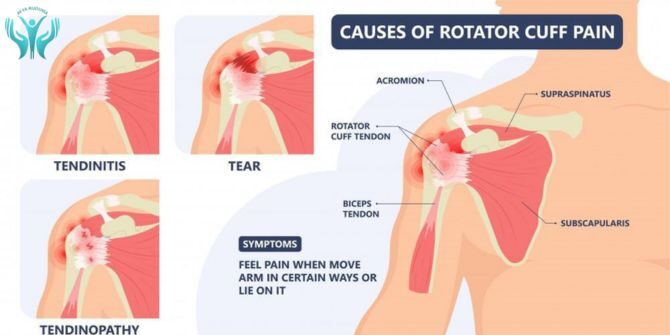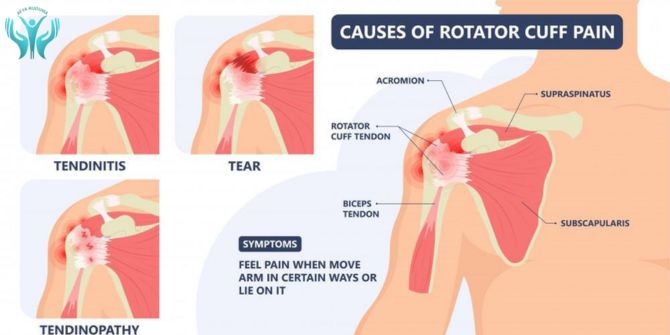
What is Rotator Cuff Injury, let’s know about it
What is a Rotator Cuff Injury?
Think of your shoulder as having a team of bodyguards called the rotator cuff. They ensure your arm bone stays in place. Overworking them, like in jobs or sports with overhead movements, can lead to a “rotator cuff injury.”
It’s like the bodyguards protesting with pain, especially at night, disrupting your sleep. Age and health issues like diabetes can make them more prone to this.
So, give your bodyguards a break, avoid too much heavy lifting, and keep them happy
Types of Rotator Cuff Injury
There are two main types of torn rotator cuffs, each with its own characteristics and implications.
Partial Tear
Imagine the rotator cuff as a bridge between your shoulder muscles and arm bone. Sometimes, this bridge can get a little scratched, but it doesn’t break entirely.
When there’s a partial tear, it means the tendon connecting the shoulder muscles to the arm bone is damaged but still holding on in some places.
It’s like a torn page that’s not completely ripped out of a book – there’s still a connection, but it’s not as smooth as before.
Complete Tear
Think of the rotator cuff as a strong link between your shoulder muscles and arm bone. Now, if this link totally snaps, it’s like the tendon (the link) completely letting go of the bone.
This creates a hole or a rip in the tendon, making it a full-thickness tear. It’s a serious injury, like a bridge collapsing – causing more pain and making it harder to move your arm.

Rotator Cuff Tear Symptoms
When your shoulder’s superhero team, the rotator cuff, is dealing with tears, it sends out distress signals in various ways. Here are the signs to pay attention to:
- Pain and Weakness: If your arm hurts or feels weak when you lift, lower, or twist it, that could be a red flag.
2. Sounds or Feelings: Some folks hear or feel things like pops, clicks, or crackles when moving their arm in certain ways. It’s like your shoulder trying to tell a story.
3. Nighttime Trouble: Imagine your shoulder having a grumpy night – pain tends to get worse when the lights are out.
4. Shoulder Strength Struggle: Lifting things or doing everyday tasks might become a bit of a challenge because your shoulder isn’t as strong as it used to be.
Understanding these signals is like decoding messages from your shoulder team. It helps in spotting the issue early and getting the right fix-up
Also Read: Top 10 Hospitals for Esophageal Cancer in India
Causes of Rotator Cuff Injury
Dr. Raju Easwaran, Senior Consultant, Max Super Speciality Hospital, Shalimar Bagh, mentions a few causes of rotator cuff injuries:
Falling
your arm, like a superhero trying to break a fall. But sometimes, even heroes can get a little banged up.
Using your arm to cushion a fall or landing on it can cause a bruise or tear in the rotator cuff – that special team of muscles and tendons in your shoulder.
It’s like your arm took one for the team, but it might need a little patching up afterward.
Lifting or Pulling
Imagine you’re lifting something heavy, and your muscles are the heroes doing the heavy lifting. But here’s the twist: if the weight is too much or you’re not lifting it the right way, it’s like your heroes are facing a tough battle.
This is true, especially when folks at the gym attempt those shoulder workouts with super-heavy weights or not-so-heroic techniques. It’s a bit like asking your muscles to lift a mountain – they might strain or even tear.
So, it’s crucial to be a smart superhero in the gym and not give your muscles more than they can handle
Repetitive Stress
Imagine your shoulder as a superhero practicing a special move, like swinging a racket. Doing it a lot is like non-stop training, stressing out the superhero’s team, the rotator cuff.
It’s like asking them to lift heavy things repeatedly until they get tired. This stress can make your superhero’s home (your shoulder) a bit inflamed, like a tiny fire starting.
Keep reading for tips on preventing these tiny tears and keeping your shoulder superhero in top shape
Bone Spurs
Think of your shoulder as a room, and the bone as a guest who decides to overstay its welcome. As time goes by, this guest, also known as extra bone, starts growing on the part of the shoulder blade that hangs over the rotator cuff – the superhero team of your shoulder.
Now, this extra bone isn’t the best roommate. It can irritate and even damage the superhero’s helper, the tendon. It’s like having an annoying neighbor who keeps poking at your stuff.
This situation usually happens as your shoulder’s “house” gets older.
So, as your shoulder’s “landlord,” it’s essential to know about these unwanted guests and figure out how to make them behave to keep your superhero team happy and healthy
Also Read: Owner of Novo allocates $265 million from Wegovy success to tackle respiratory diseases
What are the Risk Factors for Rotator Cuff Injuries?
Your shoulder superheroes, the rotator cuff, face more challenges as you age, especially past 40. Sports heroes like baseball players and tennis pros put their shoulders at risk of injury.
Even in jobs like carpentry or painting, where arms are on the move, your superhero team gets extra strain. Keep an eye on these risks to keep your shoulder heroes strong and injury-free
What are the Complications of a Rotator Cuff Injury?
Imagine your shoulder superheroes facing a tear in their capes – that’s a rotator cuff tear. Ignoring it is like letting the bad guy win. As it gets worse, your arm’s moves get limited.
Untreated, it’s like having powerless superheroes – persistent pain and trouble using that arm. Act early to keep your superhero team strong
How is a Rotator Cuff Injury Diagnosed?
Finding out if you have a rotator cuff injury includes doing special checks and taking pictures inside your shoulder.
Physical Examination
When doctors check your shoulder, they do a bunch of tests to understand what’s going on. They push on different parts, move your arm around, and check how strong your muscles are. This helps them figure out exactly what’s wrong with your shoulder and how everything is doing overall.
Imaging Tests
To really figure out what’s going on with your shoulder, doctors use special pictures inside your body. There are three main types:
1. X-rays: Like superhero vision for bones. They can’t see tears in the shoulder muscles, but they’re great at spotting other things that might be causing pain.
2. Ultrasound: It’s like a magic wand using sound to take pictures of your muscles and tendons.
3. MRI: This one’s like a superhero scanner, using magnets to create super-detailed pictures inside your shoulder.
By looking at these pictures, doctors can understand exactly what’s happening inside your shoulder and pick the best way to fix it.
Treatment of Rotator Cuff Injury
Fixing a torn rotator cuff is super important for folks dealing with this issue. How the doctors help depends on how bad the tear is and what problems it’s causing.
Conservative
If your shoulder tear isn’t too bad, doctors often go for simpler treatments:
1. Take a Break: Your shoulder needs a timeout to get better. Resting is a big part of fixing a tear.
2. Ice It Up: Putting ice on the hurt area can help it feel better and calm down any swelling.
3. Move It Right: Doing special exercises with a therapy expert helps make your shoulder stronger and more flexible. It’s like a workout designed just for your shoulder. This exercise plan is also super important if you end up having surgery.
Injections
When the pain is making your everyday life tough or stopping you from getting better with exercises, doctors might suggest a shot of special medicine right into your shoulder.
This can make the pain go away for a little while, but it’s like a superhero that might not stick around forever. Also, it could make your shoulder a bit weaker, and that might make surgery trickier later on.
For the best help with your shoulder, it’s a good idea to talk to the experts at the best orthopedic hospital in India.
Surgical Options
If your shoulder tear is really serious, doctors might decide that surgery is the best fix. There are a few ways they can do it:
1. Tiny Camera Magic: They might use a tiny camera and special tools to put the torn part back together through small cuts. It’s like fixing things with super-small superhero tools.
2. Big Fix: Sometimes, if it’s really bad, they need to make a bigger cut to get things back in place. It’s like a superhero with a bigger tool belt.
3. Tendon Swap: If the tear is too much, they might use another nearby tendon to replace the damaged one. It’s like giving your shoulder a new piece to make it work better.
4. Super Shoulder Replacement: For massive tears, they might even use a superhero move and replace part of your shoulder with a special joint. It’s like giving your shoulder a whole new power-up.
Recovery after a Rotator Cuff Injury
Getting better from a shoulder tear is different for everyone, depending on how bad it is and what treatment you get.
If it’s not too serious, you might be back to normal in a few weeks or a few months with the right care. But if it’s a big tear, it could take a lot longer, especially if you need surgery.
The key is finding the right balance between resting and moving. Resting too much can actually make your shoulder get all stiff and frozen, so it’s like finding the sweet spot between taking it easy and doing the exercises the doctor recommends. That way, you can get back to doing your superhero moves in no time
Preventing Rotator Cuff Injuries
If you’re worried about hurting your shoulder or if it’s been hurt before, doing some daily stretches and exercises can be like wearing a superhero shield to prevent future injuries.
Usually, people work out the muscles in the front of their upper body, but it’s just as important to make the muscles in the back of your shoulder and around your shoulder blade strong. It’s like giving your shoulder a balanced workout.
You can team up with an orthopedic superhero or a workout expert to make a plan that suits you. And in super serious cases, they might even use a special camera to fix things up if needed. So, keep those shoulder muscles strong and superhero-ready







Leave a reply